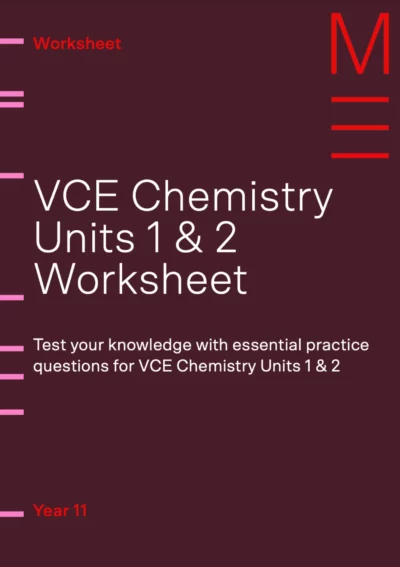Welcome to Matrix Education
To ensure we are showing you the most relevant content, please select your location below.
Select a year to see courses
Learn online or on-campus during the term or school holidays
Learn online or on-campus during the term or school holidays
Learn online or on-campus during the term or school holidays
Learn online or on-campus during the term or school holidays
Learn online or on-campus during the term or school holidays
Learn online or on-campus during the term or school holidays
Learn online or on-campus during the term or school holidays
Get HSC exam ready in just a week
Select a year to see available courses
Science guides to help you get ahead
Science guides to help you get ahead
These VCE Chemistry Units 1 and 2 practice questions will help you sharpen your skills and feel ready for exam day.

Join 75,893 students who already have a head start.
"*" indicates required fields
Related courses
The VCE Chemistry exams are designed to challenge more than just your memory of chemical concepts—they test your ability to apply what you know to different situations. To help you study, we’ve put together 10 essential VCE Chemistry unit 1 and unit 2 practice questions that cover the most important topics and calculations.
These questions will sharpen your understanding and help you explain your reasoning more clearly. By practising them, you’ll build stronger problem-solving skills and feel ready to tackle your exams when it matters most.
Before you download the full 10 VCE Chemistry units 1 and 2 practice questions, take a look at the two sample questions below. It includes expert tips from the Matrix Chemistry team on how to answer these types of questions.


Test your knowledge with essential practice questions for VCE Chemistry Units 1 & 2.

Fill out your details below to get this resource emailed to you.
"*" indicates required fields
Before we take a look at sample questions from our free VCE Chemistry units 1 and 2 practice worksheet, here are some strategies to boost your VCE Chemistry study.
1. Understand the basics:
2. Use visuals to learn faster:
3. Break down problems:
4. Link bonding to properties:
5. Connect to real-world chemistry:
Question 1
Tips:
Question 2
Tips:
Our free worksheet includes:
This resource is perfect for students looking to reinforce their knowledge and ace their exams.
Ready to take your preparation to the next level? Download our free VCE Chemistry Unit 1 and Unit 2 Practice Questions guide now! Simply fill out the form below, and we’ll send it straight to your inbox.

Test your knowledge with essential practice questions for VCE Chemistry Units 1 & 2.

Fill out your details below to get this resource emailed to you.
"*" indicates required fields
Written by Matrix Education
Matrix is Sydney's No.1 High School Tuition provider. Come read our blog regularly for study hacks, subject breakdowns, and all the other academic insights you need.© Matrix Education and www.matrix.edu.au, 2023. Unauthorised use and/or duplication of this material without express and written permission from this site’s author and/or owner is strictly prohibited. Excerpts and links may be used, provided that full and clear credit is given to Matrix Education and www.matrix.edu.au with appropriate and specific direction to the original content.